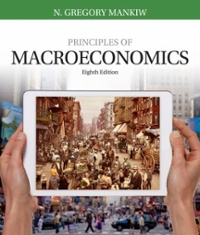Question
1) Calculate the value of the following infinitely repeated string of payoffs. a. 5 + 0.8*5 + 0.82*5 + 0.83*5 ... b. 10 + 0.5*6
1) Calculate the value of the following infinitely repeated string of payoffs. a. 5 + 0.8*5 + 0.82*5 + 0.83*5 ... b. 10 + 0.5*6 + 0.52*10 + 0.53*6 ... c. For a strategy in an infinitely repeated game, a player will get 20 each round. They have a discount rate of 0.75. What is their total utility for this strategy? d. For a strategy in an infinitely repeated game, a player will get 40 in the first round. After that, they alternate between getting 50 and getting 10. I.e. in the second round they get 50, in the third they get 10, in the fourth they get 50, in the fifth they get 10 and so on. They have a discount rate of 0.9. What is their total utility for this strategy?
2) In the game Date Night (aka Battle of the Sexes), we had two people go on a date. They could either go to a movie or go to a concert, which they must choose independently and simultaneously (e.g. they go directly to the place after work). Both most prefer spending time together, and so they get 50 utility if they both choose the same option. Player 1 prefers going to the movie and so gets an extra 20 utility for the movie, whether or not they choose the same as Player 2. Player 2 prefers going to the concert and so gets an extra 30 utility for going to the concert, whether or not they choose the same as Player 1. Assume that each player has a discount rate of 0.8. A straightforward solution to this dilemma would be for the two people to alternate where they go on dates (e.g. they go to the movie in the first round, and then the concert in the second). a. Draw the stage game of date nigh b. List all pure strategy Nash equilibria of the single stage game c. Consider a two stage version of Date Night. Does this show that the solution of alternating where to go (Movie, movie in round 1; concert, concert in round 2) is sustainable? d. Can you think of a situation in political science that resembles this?
3) Let's consider an infinitely repeated prisoners' dilemma. Assume that mutual cooperation gives each player -1 and mutual defection -5. If one player defects and the other cooperates, the defecting player gets 0 and the cooperating player gets -10. Grim trigger shows that cooperation in prisoners' dilemma is possible. However, it means that the players never forgive the defection. Let's consider a strategy of limited punishment as follows: i. Cooperate in the first round. ii. In subsequent rounds, cooperate as long as both players cooperated in the previous round. If either player played defect in the previous round, both players play defect for exactly one punishment round. iii. In the stage after the punishment round, both players cooperate no matter what b. Assume that both players play this limited punishment strategy. Draw the states for this strategy. c. Assuming that both players have a discount rate of 0.9, is the limited punishment strategy a subgame perfect Nash equilibrium? d. Assuming that both players have a discount rate of 0.1, is the limited punishment strategy a subgame perfect Nash equilibrium? e. Compare the results. Do they tell us anything about when cooperation may be sustainable in prisoners' dilemma?
4) The chicken game has often been used to model crises. Recall that in this game, the two players drive straight at each other. They can choose to swerve or keep going straight. If one swerves, and the other goes straight, assume that the one that swerves gets -10 utility and the one that goes straight gets 10 utility, since the one that swerves is deemed the loser. If both swerve, both get 0 utility. If both go straight, they crash and get -50 utility. Assume both players have a discount rate of 0.9 a. Draw the stage game of chicken b. List all pure strategy Nash equilibria of the single stage game c. Consider an infinite horizon version of Chicken. Assume that both players play the following strategies: i. Play swerve as long as both players have played swerve. ii. If one player goes straight, while the other swerves, in all subsequent rounds the player that went straight swerves and the player that swerved went straight. iii. If both players went straight, forgive and return to playing straight d. Draw the states suggested by the above strategies e. Are the strategies a subgame perfect Nash equilibrium? Be sure to check for deviations in each state. f. Can you think of a situation in political science that resembles a repeated game of chicken? What do your findings in this question tell us about that situation?
Step by Step Solution
There are 3 Steps involved in it
Step: 1

Get Instant Access to Expert-Tailored Solutions
See step-by-step solutions with expert insights and AI powered tools for academic success
Step: 2

Step: 3

Ace Your Homework with AI
Get the answers you need in no time with our AI-driven, step-by-step assistance
Get Started


